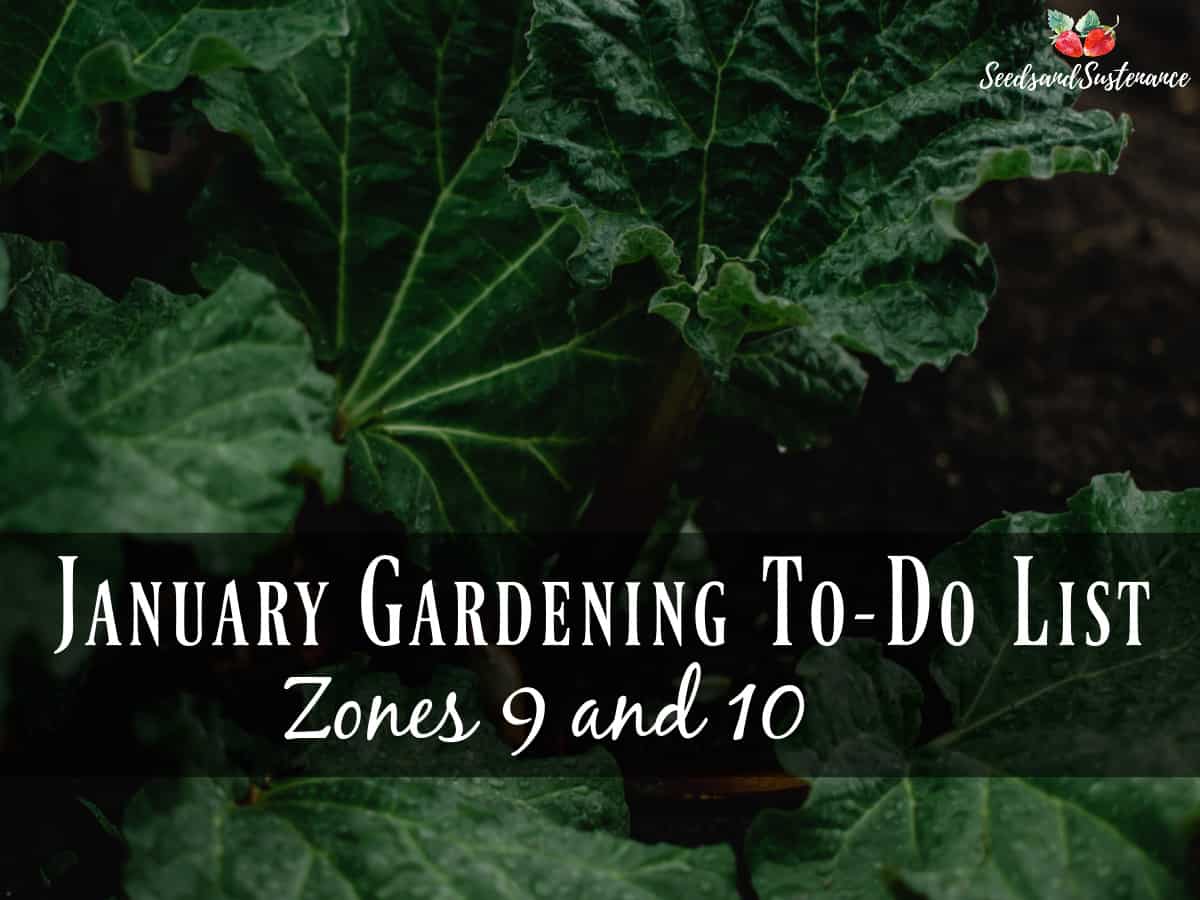
January Gardening To Do List
The first month of the year is always an exciting one, and with the mild temperatures in Southern California, it's a great time to start planning your garden projects and January gardening to do list. Whether you want to grow delicious vegetables, create beautiful flower beds, or add some outdoor decoration - January is the perfect time to get started here in SoCal.
With the perfect climate and abundant natural beauty, there are plenty of inspiring ideas for your garden designs - so why not take advantage and start prepping now to get your January gardening tasks done?
With the mild winters and perfect climate, January is an ideal time to get started on your garden projects. Whether you want to cultivate a vegetable garden, start a flower bed, or create some outdoor ornamentation, there's no better place to start than your own backyard.
Get inspired by the natural beauty around you and start planning for the season ahead.
There's SO much to do this month, so to start things off, here is a quick to-do list that you should be getting started NOW before we dive into the article:
- Research what varieties need in terms of sun exposure, water requirements, soil needs, etc. Knowing these ahead of time will save time later on when it comes to care and maintenance. This will also help you choose seeds!
- Start collecting seeds and seedlings - this way, when the appropriate planting season comes around, you'll be ready! There is currently a huge shortage on many seeds since everyone got into gardening in 2020. Be sure to grab what you need NOW before supplies sell out!
- Order your perennials like horseradish, rhubarb, asparagus, and artichokes.
- Plan out where your warm-season crops are going to go and write it down. This will help prevent over-sowing if you have limited space or overdid it on the cold-season crops that are still in the ground.
- Begin garden preparation by clearing away any weeds or debris that may be present.
- Amend your soil now while your seedlings are just getting started. This helps break up the load of work in the garden. This season is busy for us here in zones 9 and 10.
- Build any new structures you need NOW so that you have them done and ready to go for the season ahead. You don't want to have to do this when you're garden is exploding with produce - believe me, you'll get burnt out trying to keep up with harvesting and projects, so just get those projects done now while things are slow.
- If building new garden beds, consider using raised beds which will provide better drainage, especially if you have clay soil. No dig beds are also fantastic!
- Start composting now so that you have nutrient-rich soil to add to your garden as the season progresses.
Remember - it all starts with planning! Set aside some time each week to work on your garden, and before you know it, you'll have everything ticked off your list.
Let's dive in!
Vegetables to Plant In January - Southern California January Gardening To Do List
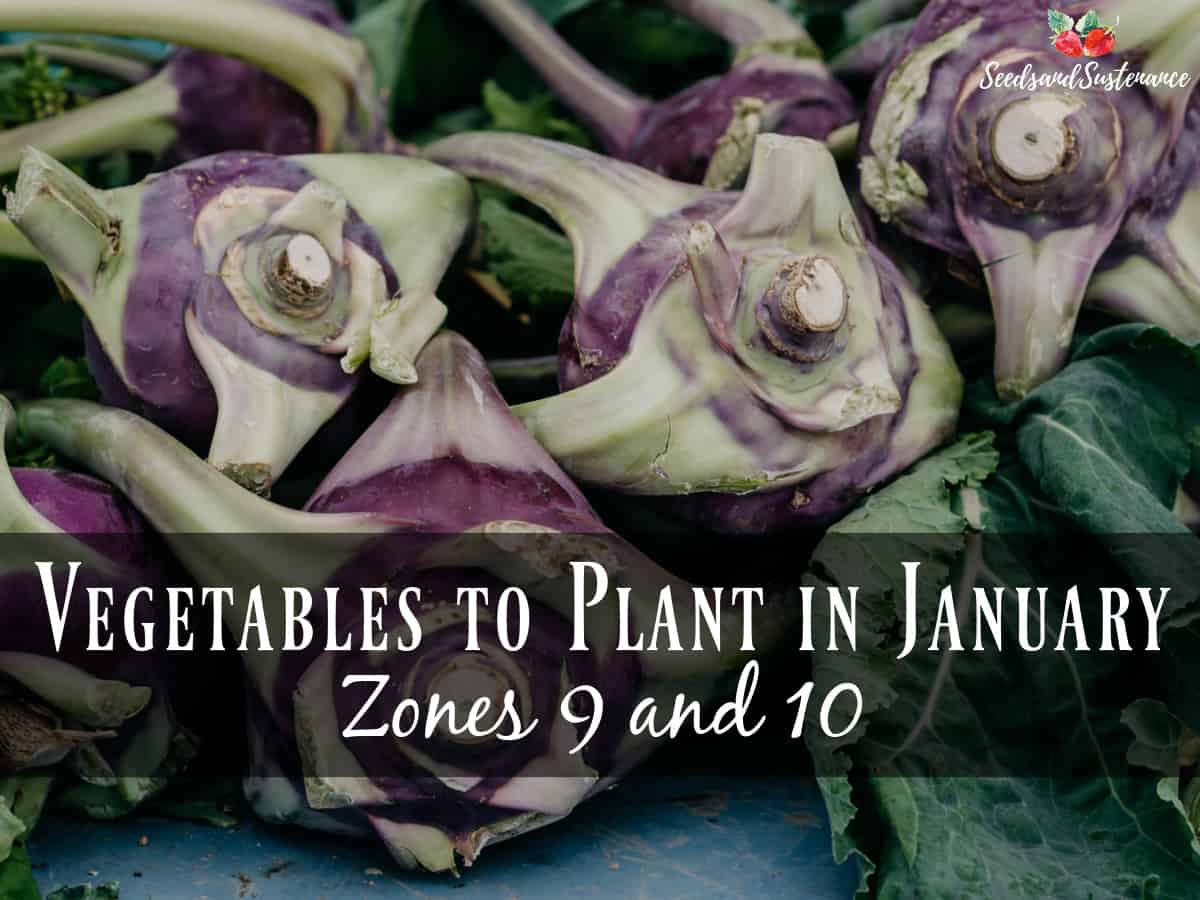
Vegetable gardening is a great way to get outside and enjoy the mild weather of Southern California in January. It's an activity that many people of all ages can enjoy, from families to first-time gardeners.
Growing your own food is also a great way to eat fresh, healthy produce on a budget. It takes some planning and preparation - researching what plants need in terms of sun exposure, water requirements, and soil needs - but once you have those basics down, it's just a matter of finding the right spot for your garden and getting started!
January is a really exciting time of year here in Southern California. It means we can finally start seeds for all our spring, and yes, even a few summer favorites.
So grab your seed catalogs and a cup of tea, and let's get to work.
Here's my list of vegetables to plant in January:
- Arugula **
- Asian greens ** (like mizuna, tatsoi, Chinese broccoli, etc.)
- Beets **
- Bok choi/Pak choi **
- Broccoli **
- Cabbage **
- Carrots **
- Cauliflower **
- Celery
- Collard greens **
- Endive **
- Eggplant (start these inside where it's warm over a seedling heat mat and transplant in late March)
- Fava beans **
- Fennel **
- Green onions **
- Kale
- Kohlrabi **
- Leeks
- Lettuce **
- Mustard greens **
- Parsnips **
- Peas **
- Peppers (start inside on a seedling heat mat and transplant in late March)
- Radishes **
- Rutabaga **
- Salad greens **
- Short-day onions (get them as plant starts HERE.)
- Spinach **
- Swiss chard **
- Tomatoes (start these indoors where it's warm and transplant them into the garden in March)
- Turnips **
** Means you can succession sow these varieties every few weeks.
There are many vegetables in season in January, so be sure to take advantage of all the wonderful things you can grow this month!
January Flowers to Plant in Zones 9 and 10
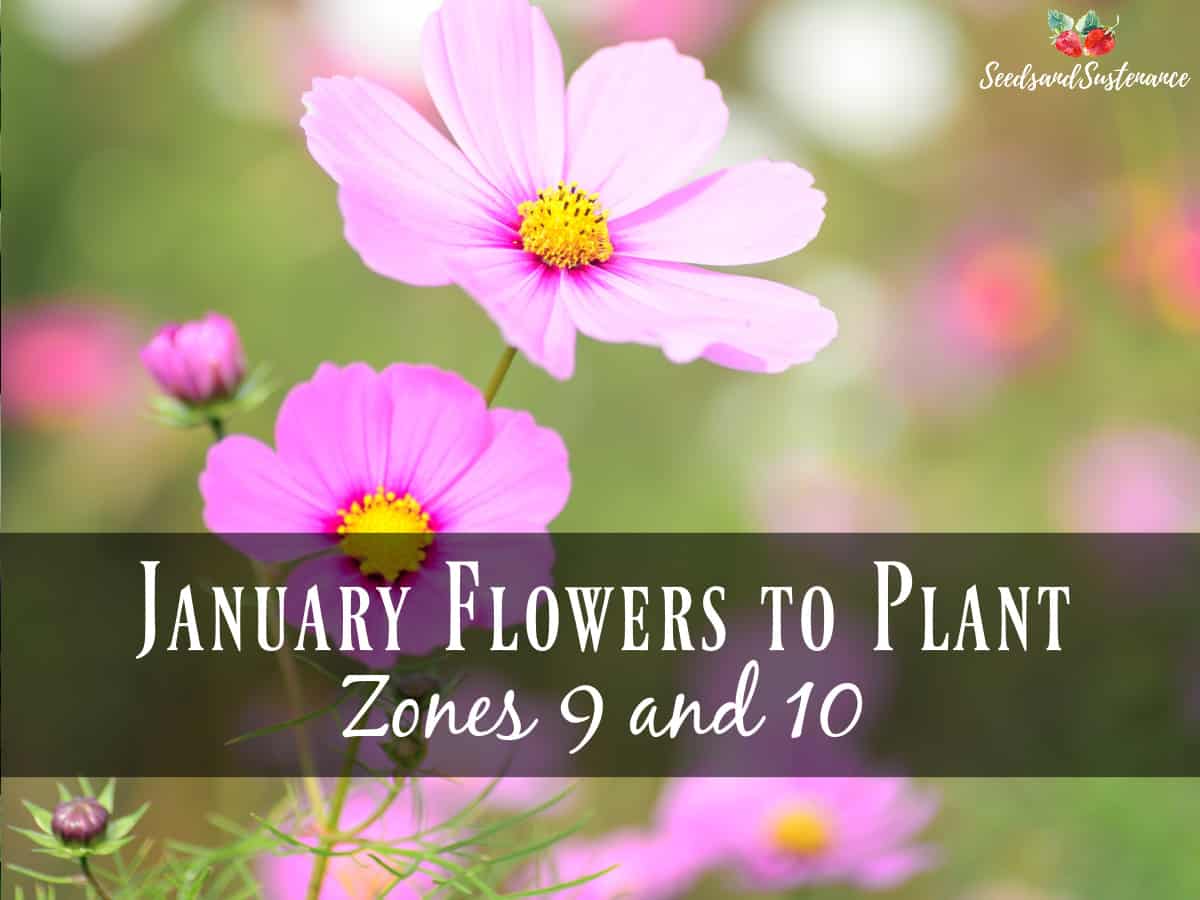
January is an exciting time to add color and life to your garden with flowers. Many varieties can bloom during this cooler month, making it the perfect time to plant some of your favorite blooms.
This time of year, even in zones 9 and 10, can be bleak and cold, but adding colorful flowers to your garden can create a beautiful and unique experience. Not only do flowers bring life and beauty to any outdoor space, but they also have many other benefits as well.
Planting flowers in the winter months can provide important food sources for birds and beneficial insects like bees and butterflies and will bring life and beauty to any outdoor space with their brilliant colors and delightful scents.
Whether you’re creating a cutting garden or just want some color to cheer up a winter day, there are plenty of flowers in season in January that can add beauty and joy to your garden.
Here are a few January flowers to consider:
- Sweet Alyssum **
- Borage **
- Calendula
- Cornflower
- Cosmos
- Dianthus
- Echinacea
- Gomphrena
- Hyssop
- Marigold
- Nasturtium **
- Nigella **
- Pansies
- Petunia
- Poppy
- Violas
- Snapdragons
- Sunflowers **
- Sweet pea **
- Wildflowers
** Means you can succession sow these varieties.
Flowers in January are a wondrous thing! I'm particularly excited about the sunflowers this year since I finally got around to sowing them in the garden. Hopefully, they do well, and I can share them with you as the season progresses.
Herbs to Plant in January - January Gardening To Do List
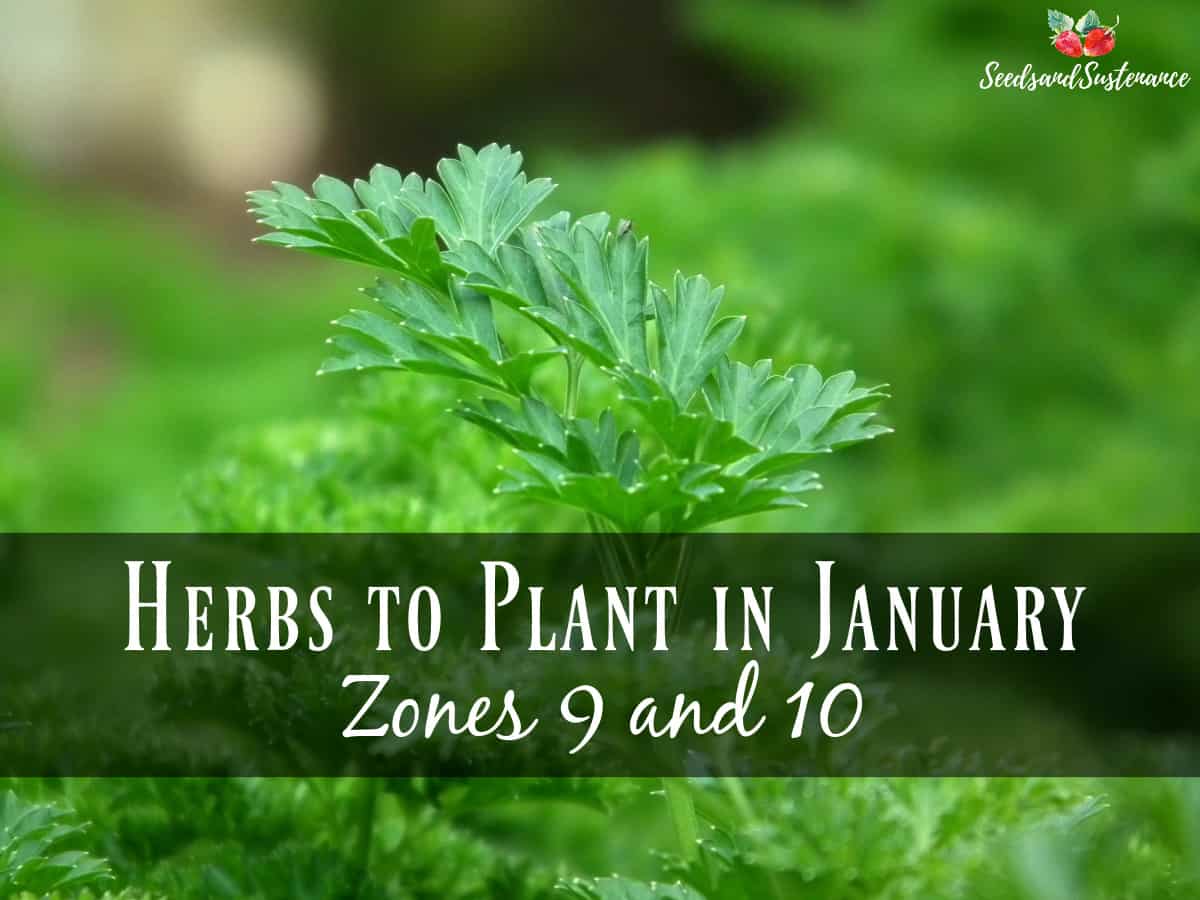
January is the perfect time to start planning your herb garden for the year. It's a great way to enjoy fresh herbs all season long!
Southern California has particularly mild winter temperatures, making herb gardening possible year-round. If you haven't started growing herbs in your garden, you really should!
Here are some excellent reasons to start your herb garden in January:
- You’ll have fragrant herbs ready for use by springtime.
- Perennial herbs, like lavender and rosemary, will establish strong root systems before the summer heat arrives and stay all year round.
- It’s a great way to add fresh flavor to your favorite dishes without having to purchase them at a store.
- Planting herbs can help attract beneficial insects, like bees and butterflies, which can help pollinate other plants in your garden.
- Herbs need less water than most vegetables, making them ideal for dry climates.
- Herbs can be used as a way to confuse pests by interplanting them with vegetables in your garden beds.
No matter what part of Southern California you live in, there's always plenty of sunshine and mild temperatures to provide the perfect backdrop for a thriving herb garden all year long!
Here are some herbs to start in January in Southern California:
- Chives ** (garlic and onion varieties)
- Cilantro **
- Dill **
- Lovage **
- Parsley **
- Sorrel
- Rosemary
- Thyme
- Lavender
- Oregano
- Sage
- Lemon balm
- Mint
** Means you can succession sow these varieties.
You may also enjoy reading:
Frequently Asked Questions
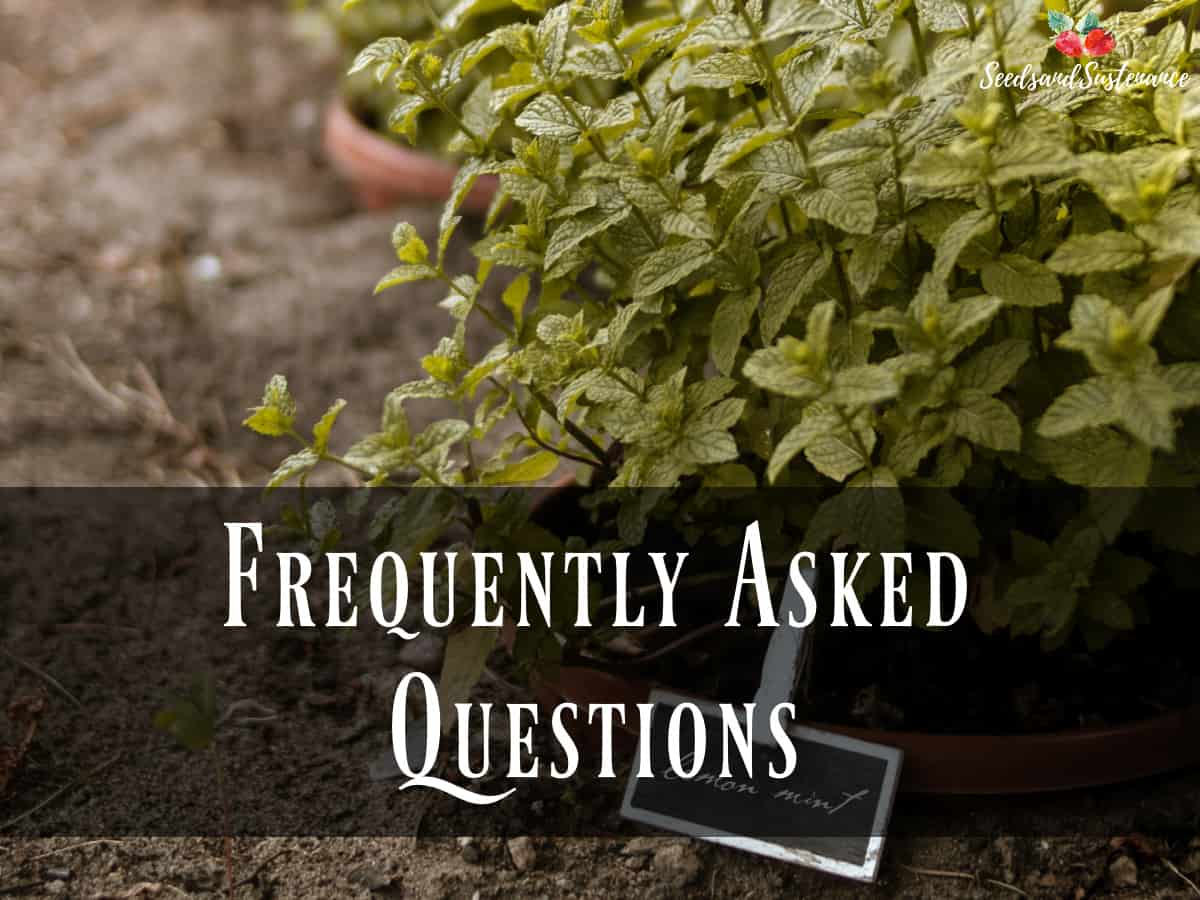
What do you plant in your garden January?
There are a variety of vegetables, flowers, and herbs you can grow in January including salad greens, root vegetables, and even tomatoes and peppers if sown indoors or where it's warm, like a greenhouse (you can even get smaller greenhouses)
Flowers include varieties like poppy, cosmos, borage, and nasturtium.
Herbs you can grow include chives, cilantro, dill, and parsley.
How do I start a garden in January?
Starting a garden in January might sound daunting, but with the right preparation and effort, it can be easy and fun!
Here are some simple steps to help you get started:
- Choose a space for your garden - consider your space size, light levels, and any existing shade or obstacles.
- Research what plants will work best in the space by taking into consideration climate zone, growing season, and soil type.
- Purchase quality soil suitable for your choice of plants, as well as any other materials you may need, such as containers, tools, or trellises.
- Get planting! Depending on your plant selection, you may need to start some of them indoors.
- Be sure to keep an eye on the weather forecast and prepare accordingly (e.g., cover tender plants with protective material when needed).
- Water weekly throughout the winter months - too much water can lead to disease; not enough can cause stunted growth or lack of blooms come summertime.
- Prune any existing outdoor plants prior to the arrival of frost to ensure healthy growth later on in the season.
- Finally - enjoy watching your plants bloom!
Can anything be planted in January?
In January, there are several vegetables that can be planted in zones 9 and 10.
Here is a list of some vegetables suitable for planting in the winter months:
- Broccoli
- Carrots
- Kale
- Lettuce
- Onions
- Radish
- Spinach
- Turnips
And many others!
What should gardeners do in winter?
Winter can be a challenging time for gardeners, but there are still plenty of things to do.
Here are some gardening jobs to do in the winter months:
- Prune shrubs and trees to encourage new growth in spring.
- Amend your soil - it's a great time to perform soil tests and improve soil structure with organic matter.
- Start planning and ordering seeds for spring planting.
- Mulch around plants to protect them from cold temperatures.
- Protect tender plants from frost by covering them with protective fabric like row covers.
- Clean and store garden tools.
- Clean your garden - weed and build new structures and beds you want for next season.
- Buy bare-root trees and get them planted.
- Keep your bird feeders filled for local birds.
How late can you start a vegetable garden?
Generally speaking, you can start a vegetable garden anytime during the growing season.
Depending on your location, the growing season typically runs from late March or April until October or November.
In SoCal, the growing season is almost all year round, with just a few weeks where frost may happen, usually in the month of January.
However, there are some vegetables that can be planted later in the season.
Some examples include:
- Beets
- Broccoli
- Brussels sprouts
- Cabbage
- Carrots
- Lettuce and other greens
- Radishes
- Spinach
- Turnips
How should I start my garden in January?
Although winter is not the ideal time for gardening in most parts of the country, there are still things you can do to prepare for a successful garden in the spring, no matter where you live.
Here are some gardening tips for starting your garden in January:
- Research what crops grow well in your area and start buying seeds. Start small!
- Make a solid plan about where you want to plant your seedlings.
- Start seeds indoors so they'll be ready to plant when warmer weather comes.
- Assemble supplies you might need, such as seed trays, heat mats, lighting, structure supplies like garden beds or trellises, soil, compost, mulch, and fertilizers.
- Prune trees and shrubs to thin out branches and encourage new growth.
- Improve soil structure by adding organic matter like organic matter or manure. I like bokashi tea and compost.
- Clean and store tools until you're ready to use them again in spring.
What can I start growing indoors in January?
January is a great time to start growing inside, regardless of the weather outside.
Here are some plants that can be started indoors in the month of January:
- Herbs like parsley, rosemary, and thyme
- Lettuce and other leafy greens
- Tomatoes and peppers
- Peas and beans
- Carrots and other root vegetables
- Beets and radishes
- Flowers such as violas, stocks, sweet peas, and petunias
What can gardeners do in January?
Gardeners can stay busy in January by doing the following:
- Plan out the garden for the next growing season. and start buying seeds.
- Prune trees and shrubs.
- Research what plants grow best in your climate.
- Reorganize garden beds and add new ones if needed.
- Clean, sharpen, and store tools for future use.
- Improve soil structure by adding organic matter like compost or manure.
- Start seeds inside on seedling heat mats so they'll be ready to plant when warmer weather arrives.
How do you take care of a garden in the winter?
Taking care of a garden in the winter is an important part of maintaining a healthy, productive garden.
Here are some garden chores to take care of for the winter season:
- Plan for the year ahead, make a list and start buying seeds and supplies beyond the winter garden season.
- Monitor temperatures and protect plants from cold temperatures.
- Remove dead leaves, weeds, and other debris from the garden.
- Mulch around plants to help insulate them from harsh temperatures.
- Water regularly, but not too often, as this can cause root rot.
- Keep an eye out for pests or diseases that could be affecting your plants.
- Keep on top of weeding.
- Repot plants as needed and use old pots for new plants you pick up at the garden center. Plant outdoors once temperatures rise.
- Remove diseased plants.
- Cover plants with frost cloth if necessary to keep them warm overnight.
Can you still garden in the winter?
Yes, you can still garden in the winter! Many people are hesitant to start a garden because they think it's only something that can be done during the warmer months.
But with some creativity and planning, you can successfully grow plants in the winter season as well.
Here are a few things to keep in mind when gardening in cold weather:
- Choose plants that can tolerate colder temperatures.
- Use insulation such as blankets or tarps to protect tender plants from freezing temperatures.
- If your area has warm spells during the winter, take advantage of them by getting out and doing some planting and maintenance tasks.
- Watering needs may be different than what is required during the summer months, so adjust accordingly.
- Keep an eye on pests and diseases, as these issues don’t always slow down in cold weather.
What plants can you plant in cold weather?
When it comes to gardening in cold weather, there is a variety of plants that can tolerate colder temperatures.
Here are some examples of plants that you can grow in the winter:
- Cruciferous vegetables, such as broccoli and cauliflower.
- Leafy greens like kale, spinach, and lettuce.
- Root vegetables like carrots, beets, parsnips, and turnips.
- Herbs like chives and parsley.
- Flowers, such as poppies or cosmos.
What grows in extreme cold?
While extreme cold makes it difficult to garden, there are many plants that can tolerate temperatures below freezing.
Here are a few examples of plants that grow in very cold climates:
- Perennials like forget-me-nots and snowdrops.
- Evergreens such as juniper and spruce trees.
- Hardy vegetables like swiss chard and kale.
- Reindeer lichen, which is often used to feed reindeer.
- Certain herbs, including rosemary and thyme.
Is it OK to plant in cold weather?
In general, it is not recommended to plant in cold weather as temperatures below freezing can damage the roots and kill the plants.
However, some hardy varieties are able to withstand colder temperatures and can be planted at any time during the year.
Before planting, it is important to check local climate information to ensure that the temperature won't drop too low for the plants you have chosen.
Can you plant any plants in winter?
I you live in Southern California, then you certainly can! There are many things you can plant, ranging from broccoli, swiss chard, and peas to chives, onions, and cilantro.
Is it bad to plant in the winter?
While it is generally not recommended to plant in cold weather, there are some hardy plants that can tolerate colder temperatures and be planted in the winter.
Also keep in mind that while certain plants may survive cold temperatures, they will likely grow slower or remain dormant until temperatures rise again.
What temperature is too cold planting?
The optimal temperature for planting varies depending on the type of plant. Generally, temperatures below 45°F (7°C) are considered too cold, as this can impede growth or damage the plants.
Can any plants grow in the winter?
There are some hardy plants that can tolerate colder temperatures and be planted in the winter. These plants include some varieties of grass, bulbs, flowering shrubs, trees, evergreens, etc.
If you live in a warmer zone, like zones 9 and 10, you will be to grow MANY different kinds of plants, including vegetables, greens, flowers, and herbs.
What are good things to plant in January?
In Southern California, some good options for planting in January include:
- Bulbs (such as daffodils, tulips, and hyacinths)
- Shrubs like forsythia, witch hazel, and viburnum
- Perennials such as primroses and pansies
- Annuals like poppies, calendulas, and snapdragons
- Trees (fruit trees, like citrus trees, and ornamental varieties)
- Lots of cold-weather crops like broccoli, greens, and root vegetables! (Winter salads are the best!)
Is it OK to plant things in winter?
The short answer is yes, it is possible to plant things in winter in Southern California. However, it is important to pay attention to the climate and the type of plants that you are planning to plant.
Certain bulbs, perennials, annuals, and trees can survive colder temperatures, while others may slow their growth or become dormant until warmer weather returns.
What plants can I start inside in January?
In January, there are several plants that you can start inside your home.
These include:
- Herbs such as basil, chamomile, and parsley
- Ornamental flowers such as petunias and impatiens
- Vegetables like tomatoes, peppers, and eggplants (use a seedling heat mat to get them to germinate)
- Sunflowers
What should I start in January?
There are a variety of seeds that can be planted in January.
These include:
- Herbs like parsley, sage, and chives
- Flowers like calendula, petunias, and vinca
- Vegetables like tomatoes, peppers, eggplants, and root vegetables
- Fruit trees such as apple and peach trees
- Grains such as wheat, oats, and rye
What vegetables can be started in winter?
In the winter months, there are several vegetables that can be started inside.
These include:
- Lettuce and greens such as spinach, kale, and arugula (also Asian greens like bok choi, mizuna, and mustard greens!)
- Root vegetables such as carrots, beets, and radishes
- Peppers
- Tomatoes
Can you start a garden in January?
Yes, it is possible to start a garden in January in Southern California.
The warm climate and long growing season of the region make it ideal for cultivating vegetables such as lettuces, peppers, tomatoes, carrots, beets, and radishes.
How do I keep my garden plants alive in the winter?
Keeping your garden plants alive during winter in Southern California requires careful preparation and maintenance.
Here are some tips to get you started:
- Research what varieties of plants are best suited for your area and make sure you choose ones that can survive cold snaps.
- Cover any vulnerable plants with a frost cloth or mulch when possible.
- Water deeply but infrequently to keep the soil moist and protect plants from freezing temperatures.
- Make sure to add compost or manure before the winter season to help insulate and add nutrition to your plants.
What are the best fruits to plant in winter?
There are several fruits that thrive when planted during the winter season in Southern California.
Some of the best options include:
- Citrus fruits such as oranges, lemons, limes, and tangerines.
- Stone fruits like peaches, plums, nectarines, and apricots.
- Berries such as strawberries, blackberries, blueberries, and raspberries.
- Apples and pears.
Can you keep plants in pots over winter?
Yes, it is possible to keep plants in pots over winter if the conditions are right.
Here are some tips for successfully overwintering plants in containers:
- Choose hardier varieties of plants that have been specifically bred for the purpose of surviving cold temperatures.
- Make sure your pots have enough drainage to prevent too much moisture from accumulating.
- When cold outside, use frost cloth to protect plants from cold temperatures.
- Place your pots somewhere that will be sheltered from strong winds, such as near a wall or under a tree. A South-facing wall will keep plants warm.
- Water plants regularly but sparingly during this time to keep the soil from drying out completely.
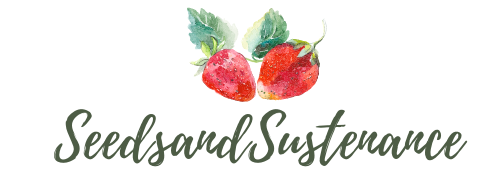

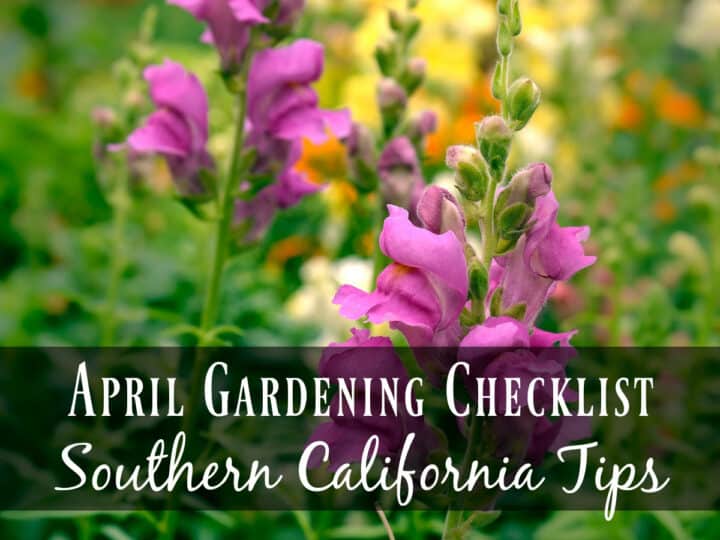
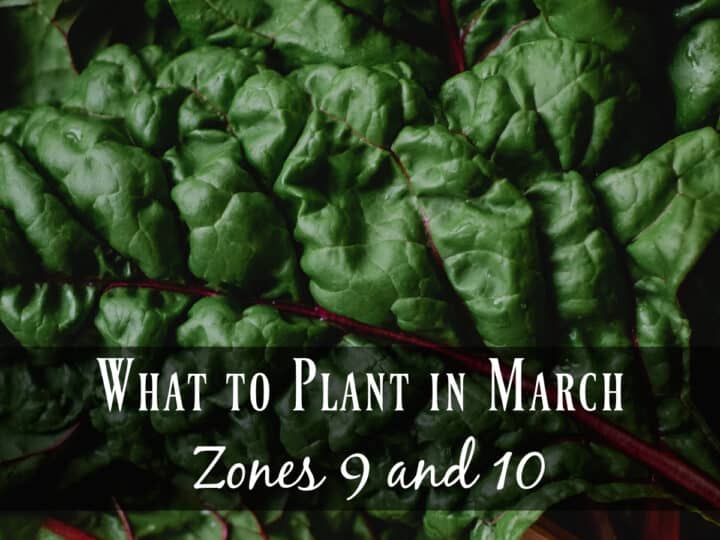
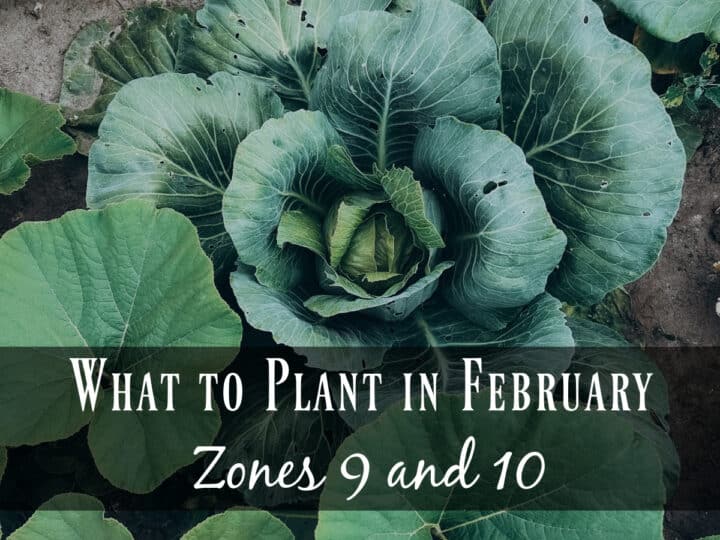
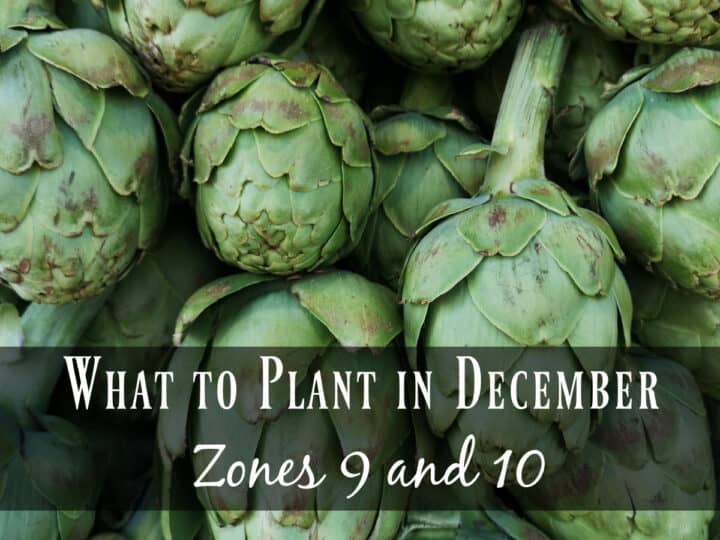
Leave a Reply